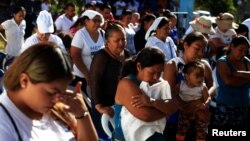Extreme violence in Central America is forcing aid agencies to use conflict-zone tactics to reach people most at risk in gang-plagued nations such as El Salvador and Honduras, where homicide levels are comparable to those in war, experts say.
High numbers of people fleeing the region are suffering psychological problems such as post-traumatic stress disorder (PTSD), according to a humanitarian discussion this week, amid calls for governments to step up support for those unable to leave violent areas and others escaping north.
“Engaging and delivering assistance in areas controlled by gangs, ‘maras’ or other criminal organizations follows the same approach as in conflict settings,” said Marc Bosch Bonacasa, Latin America program manager for Medecins Sans Frontieres (MSF).
Some of the most dangerous cities
The international medical charity follows a principled approach based on neutrality and independence, coupled with analysis and dialogue according to the positions and interests of violent actors, he said.
Central America has some of the world’s most dangerous cities. Gang violence and grinding poverty have forced hundreds of thousands to leave their homes and make the often perilous trek through Mexico, to try to enter the United States.
Negotiating with gangs is often essential for aid organizations to get secure access to the people they need to help, said Christian Visnes, Norwegian Refugee Council (NRC) director for Colombia and the region.
But local humanitarian groups are among the most vulnerable to high levels of violence that could yet increase, he added.
Cash payments provided by the NRC are allowing families from cities such as San Pedro Sula in Honduras to move to safer areas or migrate, he said, while neighborhood education plans give children the chance to learn locally rather than risk traveling through gang-controlled areas to go to school.
For those who have received death threats, leaving home can “save their lives,” Visnes told the online event organized by the London-based Humanitarian Practice Network.
But others who cannot afford to migrate often face a dangerous fate on their home turf, he said.
“It’s sure death for one of the members of the family, or one of the children being forcibly recruited into a gang, or suffering sexual violence,” he said.
Trauma levels high
Levels of PTSD among Central American migrants treated by MSF in Mexico are similar to those in “traditional conflict settings,” with nearly 60 percent of women showing signs of depression, Bosch said.
He urged more support for unaccompanied children and LGBT people, who are often targeted by criminal groups.
Some people treated by MSF are suffering extreme physical pain and emotional trauma after being tortured by gangs, he said.
“The anguish and stress that migrants and refugees face, both in their home countries and along the migration route, make this population particularly vulnerable to anxiety, depression and post-traumatic stress disorder,” Bosch said.
Many migrants do not seek medical help for fear of retaliation or deportation, he added.
Violence and climate change
Violence is one of the main triggers for migration, the experts said, but it is interwoven with the impacts of climate change in countries like El Salvador and Honduras, which have suffered consecutive years of drought, forcing more people into urban areas dogged by conflict.
Femicides in the region are among the highest in the world, but men are more likely to be killed in gang-led violence, often leaving women to provide for their families, said Wendy Cue, head of the Latin America arm of the U.N. Office for the Coordination of Humanitarian Affairs.
“Violence impacts whole communities and affects their access to adequate health and education services,” she said. “While there’s a lot of focus and visibility about people who are displaced across borders, there’s less visibility [for] the people who are affected within their countries.”









